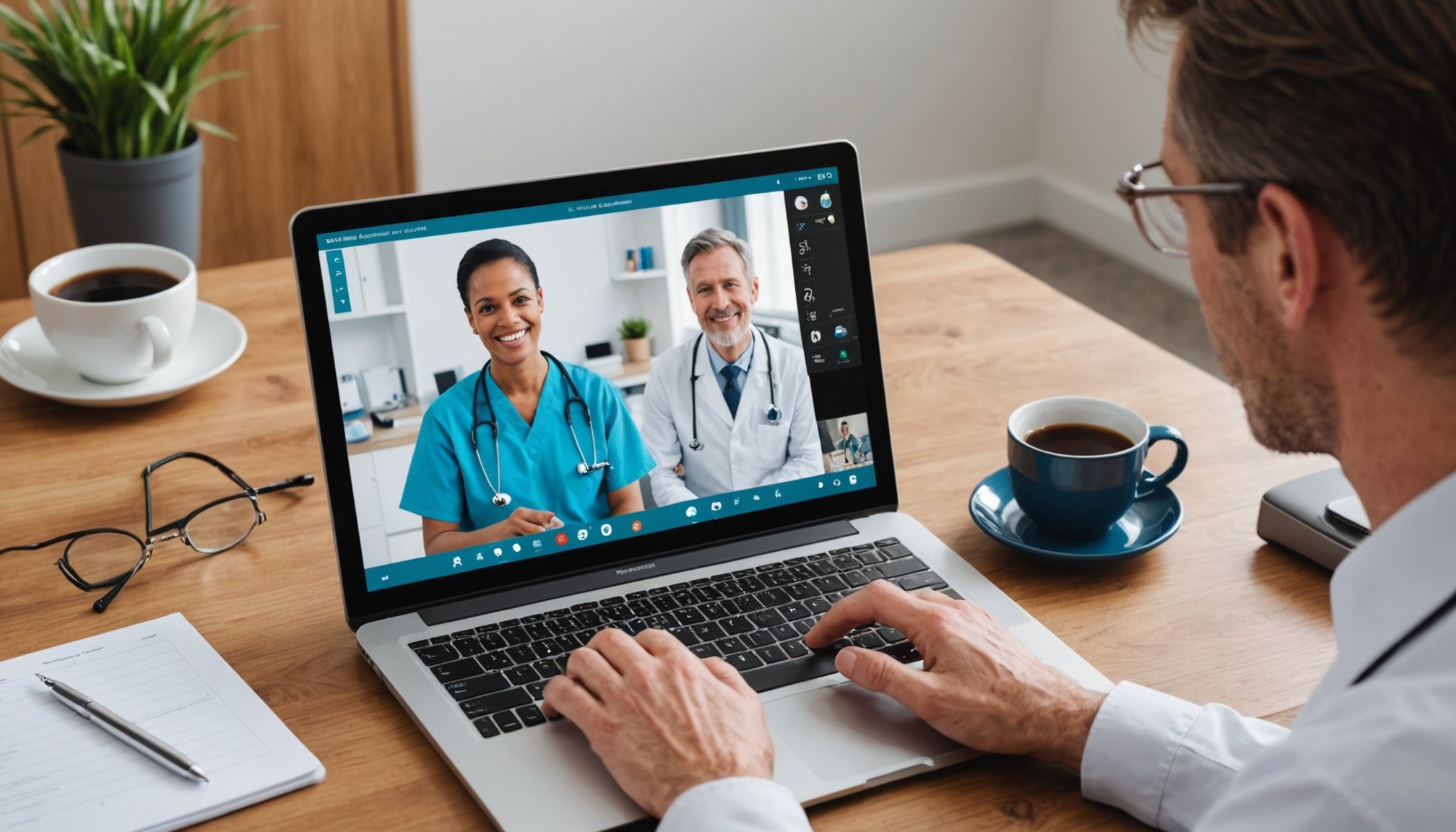Top Strategies for Successful Telehealth Integration in Rural Areas of the UK
Understanding the Need for Telehealth in Rural Areas
Telehealth, or the use of electronic communication and information technologies to provide healthcare services, has become a vital component in addressing the healthcare disparities in rural areas of the UK. These regions often face significant challenges, including limited access to healthcare facilities, long travel times, and a shortage of healthcare professionals. Here’s why telehealth is not just a convenience, but a necessity:
- Geographical Barriers: Many rural areas lack the infrastructure and resources to support comprehensive healthcare services. Telehealth bridges this gap by providing access to care without the need for physical presence.
- Workforce Shortages: The scarcity of healthcare professionals in rural areas can be mitigated through telehealth, allowing patients to consult with specialists from urban centers.
- Patient Satisfaction: Studies have shown that patients in rural areas appreciate the convenience and accessibility of telehealth services, which can lead to higher patient satisfaction and better health outcomes.
Technological Considerations for Telehealth Implementation
Implementing telehealth services in rural areas requires careful consideration of several technological factors to ensure seamless integration and functionality.
Also to see : Iranian resistance: unfolding the future of freedom in iran
Selecting the Right Technology
- Video Conferencing Platforms: Secure, user-friendly, and reliable video conferencing platforms are essential. These platforms must be compatible with existing healthcare IT infrastructure to avoid disruptions and ensure continuity of care.
- Electronic Health Records (EHR) Systems: EHR systems that are interoperable with telehealth platforms are crucial for smooth data exchange and comprehensive patient care.
- Digital Prescription Services: Ensuring that digital prescription services are integrated into the telehealth system can enhance patient care and reduce errors.
Ensuring Digital Inclusion
- Broadband Access: One of the significant challenges in rural areas is the limited availability of high-quality broadband. Health systems should collaborate with stakeholders to enhance broadband access in these areas.
- Digital Literacy: Patients and healthcare providers need to be digitally literate to effectively use telehealth services. Training programs and educational resources can help bridge this gap.
- User-Friendly Interfaces: The technology used should have simple, user-friendly interfaces to facilitate easy navigation for patients and healthcare providers alike.
Operational Strategies to Enhance Telehealth Services
To make telehealth services profitable and effective, health systems need to adopt several operational strategies.
Staffing Models and Centralization
- Different Staffing Models: Utilizing lower-cost clinicians and centralizing staffing can help reduce costs. Command centers dedicated to virtual health can oversee operations centrally, leading to cost efficiencies.
- Leveraging Technology: Automating various aspects of operations can reduce costs and increase service availability during evenings and weekends, boosting patient volumes.
Patient Education and Engagement
- Clear Communication: Educating patients about when virtual visits are appropriate and how to use the technology is crucial. This can include instructional videos, FAQs, and webinars.
- User-Friendly Digital Platforms: Creating virtual care experiences with user-friendly digital platforms and tools can enhance the patient experience and increase engagement.
Integration into Clinicians’ Workflows
- Seamless Integration: Virtual care should be seamlessly integrated into clinicians’ workflows to ensure high-quality care. Effective communication and education are essential to this approach.
- Training for Clinicians: Training is necessary for staff providing care via video to ensure they are comfortable and proficient with the technology.
Addressing Challenges and Barriers
Despite the benefits, telehealth implementation in rural areas faces several challenges and barriers.
Also read : Exploring the Future of Self-Driving Public Transportation in the UK: Innovations and Insights
Technological Limitations
- Internet Connectivity: Limited or expensive internet connectivity in rural areas can hinder the use of telehealth services. Efforts to enhance broadband access are critical.
- Complex Technology: Complex technology and long waiting times can reduce the acceptability of telehealth. Simplifying interfaces and reducing wait times can help.
Patient and Provider Reluctance
- Resistance to Change: Some patients and providers may be reluctant to adopt new digital practices. Education and training can help overcome this resistance.
- Data Security Concerns: Ensuring data security and privacy is paramount. Robust encryption protocols and multi-factor authentication are essential to safeguard sensitive data.
Practical Strategies for Overcoming Barriers
Here are some practical strategies to overcome the challenges and barriers in implementing telehealth services in rural areas:
Enhancing Broadband Access
- Collaboration with Stakeholders: Health systems should collaborate with local authorities and internet service providers to enhance broadband access in underserved areas.
Offering Incentives
- Financial Incentives: Offering financial incentives to both patients and healthcare providers can encourage the adoption of telehealth services.
Establishing Clear Guidelines
- Standardization: Establishing clear guidelines and standards for telehealth practices can help in smooth integration and reduce confusion among users. This includes defining the roles of video in urgent primary care and providing evidence-based guidelines for its use.
Case Studies and Success Stories
Several case studies and success stories highlight the effectiveness of telehealth in rural areas.
Diffuse-Dual-Channel System (DDS)
- User-Friendly Interface: A study on the DDS system showed higher satisfaction for digital connectivity due to its simpler interface compared to the Tiered-Gatekeeper System (TGS). This system also reduced the costs of telemedicine integration and minimized the chances of mistreatment.
Primary Care Services
- Video Consultations: In out-of-hours primary care services, video consultations have been found to be particularly beneficial. They provide additional information that can reduce consultation length and support clinicians’ decision-making processes.
Table: Comparison of Telehealth Models
| Telehealth Model | Key Features | Advantages | Challenges |
|---|---|---|---|
| Diffuse-Dual-Channel System (DDS) | Multi-channel communication, direct access to specialists | Higher patient satisfaction, simpler interface, reduced costs | Limited availability of high-quality bandwidth in rural areas |
| Tiered-Gatekeeper System (TGS) | Systematic patient flow and referral, embedded regulations | Reduction in referrals from rural areas, resource preservation | Complex technology, need for assistance from specialists |
| Video Consultations in Primary Care | Additional information through video, support for clinicians’ decision-making | Reduced consultation length, enhanced patient care in out-of-hours settings | Technological limitations, potential for over-reliance on technology |
Quotes and Insights from Experts
- “Health systems should strive to ensure equitable access and experiences for all consumers. Strategies should include using virtual visits to attract patients who were previously uncomfortable or unable to access the health care system,” says a report from the Deloitte Center for Health Solutions.
- “Excellent communication, training, education, exposure to modern technologies, and a positive attitude of practitioners are necessary elements for the smooth and seamless influx of telemedicine in existing healthcare systems,” highlights a study published in Nature.
Integrating telehealth services in rural areas of the UK is a complex but rewarding endeavor. By addressing technological limitations, ensuring digital inclusion, adopting effective operational strategies, and overcoming barriers, health systems can provide equitable and high-quality care to all patients.
Key Takeaways
- Invest in Reliable Technology: Ensure that the technology used is reliable, user-friendly, and compatible with existing healthcare IT infrastructure.
- Enhance Broadband Access: Collaborate with stakeholders to improve broadband access in underserved areas.
- Educate and Train: Provide comprehensive training for both patients and healthcare providers to enhance digital literacy and comfort with telehealth services.
- Establish Clear Guidelines: Develop and implement clear guidelines and standards for telehealth practices to ensure smooth integration and high-quality care.
By following these strategies, the UK can advance its telehealth capabilities, ensuring accessible and efficient healthcare for all, regardless of geographical location.











